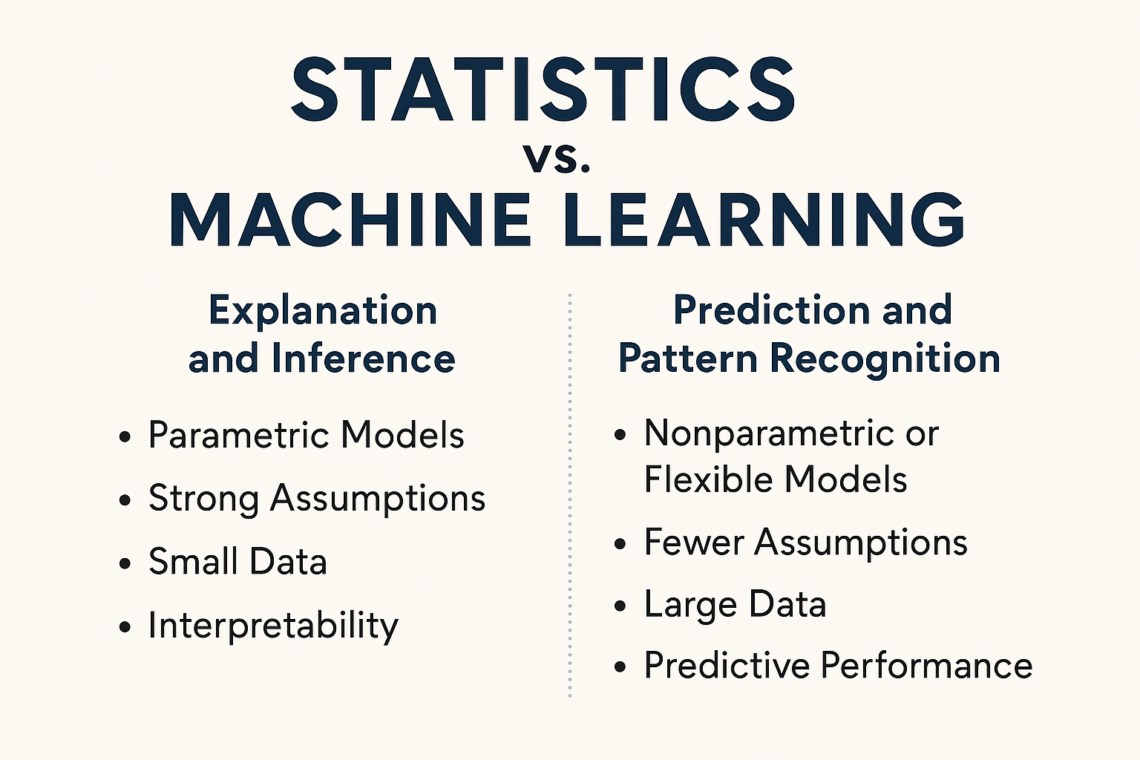📊 Statistics vs. Machine Learning: A Technical Comparison of Concepts, Goals, and Methods
In the era of data-driven decision making, Statistics and Machine Learning (ML) are two foundational disciplines that often intersect—and sometimes get confused. While both aim to extract insights from data, they differ significantly in goals, assumptions, and methodologies.
This post explores the core differences and similarities between statistics and machine learning, clarifying when and why each is applied, and how they complement each other in modern data science.
🧠 The Fundamental Goal
📈 Statistics: Inference and Understanding
The core objective of statistics is to:
- Model relationships between variables
- Make inferences about populations based on samples
- Quantify uncertainty and test hypotheses
Statistical models are often interpretable, designed to explain why something happens.
Example: Linear regression to estimate the effect of education on income.
🤖 Machine Learning: Prediction and Generalization
Machine learning emphasizes:
- Building models that generalize well to unseen data
- Optimizing predictive performance
- Automatically learning patterns from data without explicit programming
Interpretability is often traded off for predictive power, especially in complex models like neural networks.
Example: Predicting future stock prices using historical data and features.
🔍 Key Conceptual Differences
| Concept | Statistics | Machine Learning |
|---|---|---|
| Goal | Explanation and inference | Prediction and pattern recognition |
| Model type | Parametric (e.g., linear regression) | Often non-parametric or flexible |
| Assumptions | Strong (normality, linearity, etc.) | Fewer assumptions |
| Interpretability | High | Varies (often low in deep models) |
| Data size | Often small to moderate | Large-scale data |
| Validation method | p-values, confidence intervals | Cross-validation, test accuracy |
| Focus | Statistical significance | Predictive performance |
⚙️ Methodologies & Tools
Common in Statistics:
- Linear & logistic regression
- Hypothesis testing
- ANOVA, MANOVA
- Time series models (ARIMA)
- Bayesian inference
Common in Machine Learning:
- Decision trees, random forests
- Support vector machines (SVMs)
- Neural networks & deep learning
- Gradient boosting (e.g., XGBoost)
- Reinforcement learning
Interestingly, many techniques—like regression—are shared between both fields but used differently. In statistics, regression explains relationships; in ML, it’s a prediction tool.
🧪 Case Study: Predicting Housing Prices
- Statistical approach:
- Build a linear model to identify which variables (e.g., location, square footage) significantly affect prices.
- Focus on p-values, coefficients, and R² for interpretability.
- Machine learning approach:
- Use models like random forests or gradient boosting.
- Prioritize minimizing RMSE or maximizing prediction accuracy on a holdout set.
Both approaches offer value: statistics helps understand the “why”, ML helps with accurate forecasts.
🧬 Complementary Roles in Data Science
Rather than seeing statistics and machine learning as opposing approaches, it’s more productive to view them as complementary:
- Statistics provides theory, assumptions, and structure to guide model building and interpretation.
- Machine learning contributes tools that scale to complex, high-dimensional, and noisy datasets.
The best data scientists leverage both to build models that are not only accurate but also interpretable and robust.
📌 Final Thoughts
Statistics and machine learning are both vital to data analysis—but serve different needs. If you want to understand relationships and draw conclusions from data, statistics is your tool. If your goal is to predict future outcomes or automate decision-making, machine learning takes the lead.
The real power lies in combining both disciplines—drawing on the rigor of statistics and the scalability of ML to solve modern data challenges.


